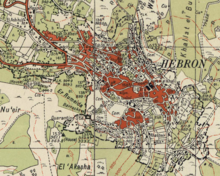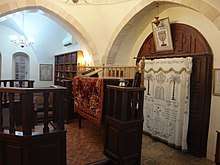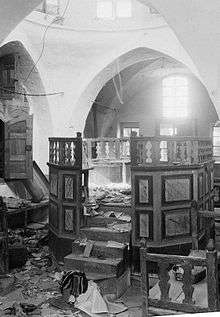Avraham Avinu Synagogue
The Abraham Avinu Synagogue (Hebrew: בית הכנסת על שם אברהם אבינו) was built by Hakham Malkiel Ashkenazi in the Jewish Quarter of Hebron[1] in 1540.[2] The domed structure represented the physical center of the Jewish Quarter of Hebron. Located in the Old City of Hebron, it became the spiritual hub of the Jewish community there and a major center for the study of Kabalah.[2] It was restored in 1738 and enlarged in 1864. The synagogue stood empty since the 1929 Hebron massacre[3] and was destroyed after 1948.[4]

History

The synagogue is mentioned by Rabbi Naftali Hertz Bachrach in his 1648 book Emek HaMelech.[5] The book deals with the kabbalah, but in the introduction, he mentions a dramatic story about the Avraham Avinu synagogue.[2][6]

Jordan took control of the area in 1948, and after this time a wholesale market, trash dump and public toilet were placed on the site of the Jewish Quarter. The ruins of the synagogue were turned into a goat and donkey pen.[7] The adjacent, "Kabbalists' Courtyard" was turned into an abattoir.[7]

In 1971 the Israeli Government approved the rebuilding of the synagogue, courtyard and adjoining buildings.[8] Work on the restoration was underway in 1976.[3]

The man instrumental in re-discovering and rebuilding the synagogue was local Hebron resident Ben Zion Tavger.[9][10] He was a prominent physicist in the Soviet Union at Gorky University noted for his work in the Magnetic Symmetry phenomenon. He moved to Israel in 1972 and became a chair at Tel Aviv University.[11][12] Tavger wrote in his book My Hebron about the Avraham Avinu synagogue:"I let my eyes wander around the interior of the synagogue. I had time to think and recall its previous state, five or six years ago, and thought of the sequence of events that had transpired. When I first came here, the place had indeed gone by the name of "Avraham Avinu Synagogue", but its name had seemed completely disconnected from its essence... To me it had seemed obvious that we had to dig and clear out the refuse and rubbish from the site, to reveal the splendor of the synagogue for all to see."[13]
Today, the rebuilt synagogue is used each Friday night by the Jewish residents of Hebron to hold prayer services. The synagogue is also open to visitors each day of the week so they can learn about the history of the synagogue, and hold private services.
Today, a plaque with the cover of the book Emek HaMelech and the full text in the original printing hangs on a plaque on the wall of the rebuilt Avraham Avinu synagogue.[14]
See also
References
- Auerbach, Jerold S. (2001). Are we one? : Jewish identity in the United States and Israel. New Brunswick [u.a.]: Rutgers Univ. Press. p. 153. ISBN 978-0813529172.
- Auerbach, Jerold S. (2009). Hebron Jews memory and conflict in the land of Israel. Lanham, Md.: Rowman & Littlefield. pp. 39–41. ISBN 9780742566170.
- Parks, Michael (4 November 1976). "Claimed by both Israel and Arabs, once-calm Hebron grows tense". Baltimore Sun.
- Fischbach, Michael R. (2008). Jewish property claims against Arab countries. New York: Columbia University Press. pp. 86–7. ISBN 9780231517812.
- Pinson, R. DovBer; Hertz, R. Naftali (2015-06-10). Mystic Tales from the Emek HaMelech. Iyyun Publishing.
- "The Cave of Machpela - Legends". www.machpela.com. Retrieved 2016-01-14.
- Jerold Auerbach (2009). Hebron Jews: Memory and Conflict in the Land of Israel. Rowman & Littlefield. p. 79. ISBN 9780742566170.
- Grose, Peter (24 July 1976). "After 42 Years, Jews Are Part of Hebron". The New York Times.
- "Hebrew video of Prof. Tavger at the Avraham Avinu Synagogue".
- "Avraham Avinu Synagogue". the Jewish Community of Hebron. Retrieved 2016-01-14.
- "My Hebron by Ben Zion Tavger". www.hebron.com. Archived from the original on 2016-02-16. Retrieved 2016-01-14.
- "The physicist who changed Hebron: The 30th Anniversary of the passing of Prof. Ben-Zion Tavger - Noam Arnon". www.hebron.com. Archived from the original on 2016-03-03. Retrieved 2016-01-14.
- Tavger, Ben Zion; Tadmor, Prima [Translator] (2009-01-01). My Hebron. Bella-Nava Tavger.
- "The Avraham Avinu Synagogue: Miracle past and present by David Wilder". www.hebron.com. Archived from the original on 2016-03-04. Retrieved 2016-01-14.
Further reading
- Auerbach, Jerold S. (2009). Hebron Jews memory and conflict in the land of Israel. Lanham, Md.: Rowman & Littlefield. pp. 2, 40, 45, 61, 79. ISBN 9780742566170.
External links
- Photo gallery of Avraham Avinu synagogue including vintage and modern pictures.
- Abraham Avinu Synagogue's website
- Avraham Avinu Synagogue page on Hebron.com
- Video of Prof. Ben Zion Tavgar discussing his excavation of the Avraham Avinu Synagogue (Hebrew)
- Video historical overview of Avraham Avinu neighborhood